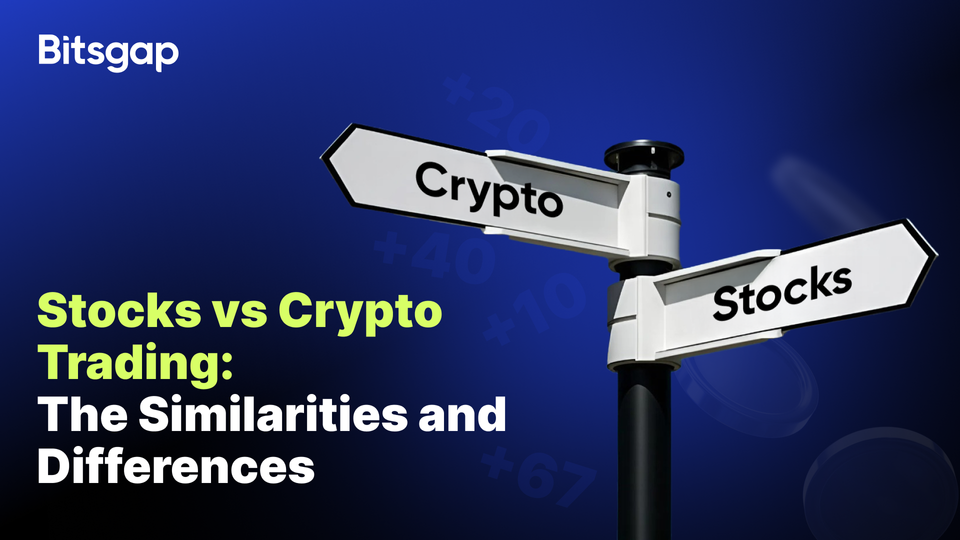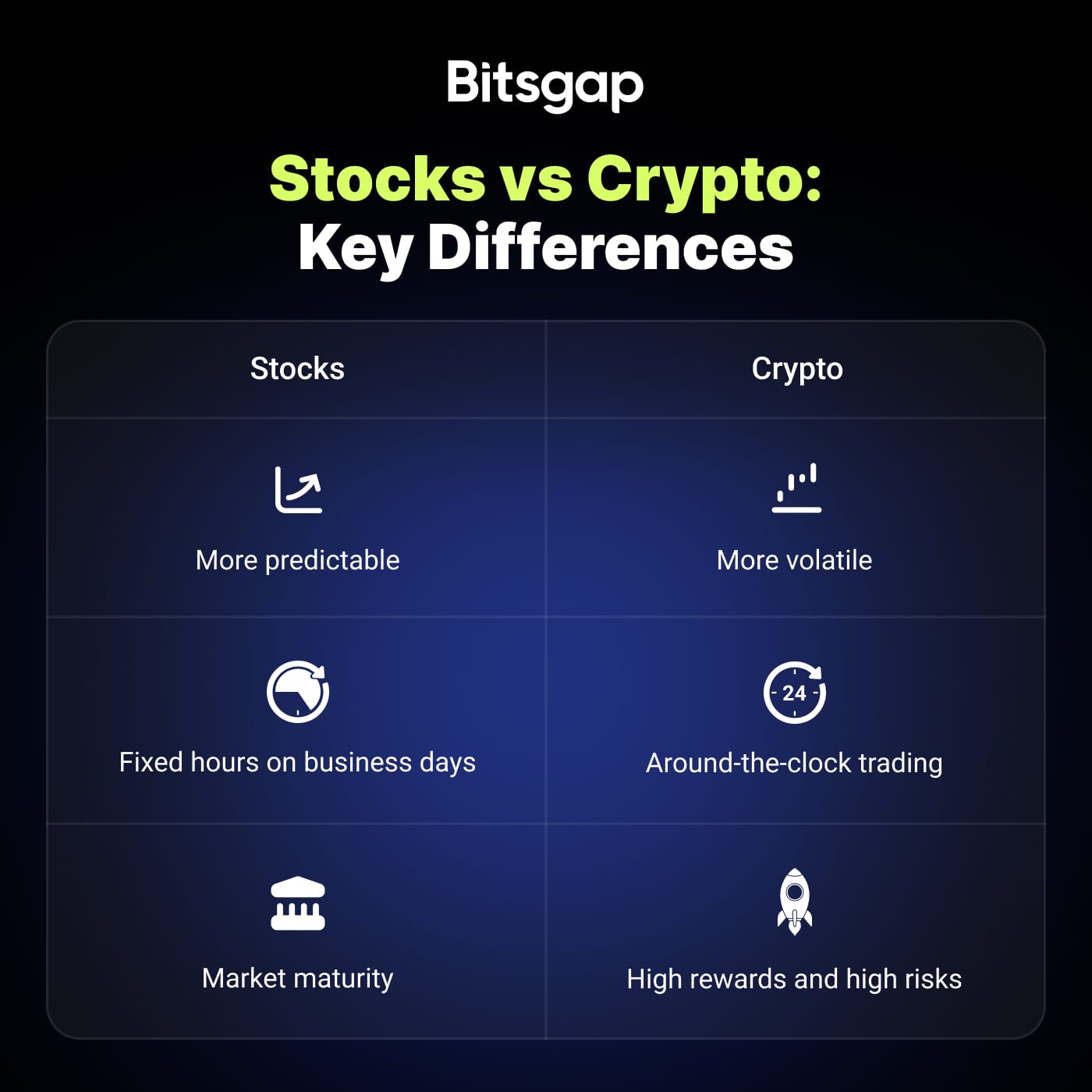
Stocks vs Crypto Trading: The Similarities and Differences
The main goal of any investor is profit, but the paths vary. Crypto and stocks are two popular options. How do they compare? Let’s explore their similarities, differences, and which may suit you best depending on your goals and risk tolerance.
Cryptocurrency vs Stocks: The Basics
The stock market allows you to own a portion of the companies you choose to invest in, even though the share is typically quite small. When you buy a stock, you are directly investing in that company’s growth and profits — and your risk is tied to the company’s performance. When it comes to returns, they may come from price appreciation or dividends.
Cryptocurrencies, on the other hand, are virtual assets, although they are bought with real money. This underlines one of the main differences between crypto vs stock market: unlike stocks, cryptocurrencies often have no underlying cash flow. Cryptocurrencies are powered by blockchain technology and can represent decentralized networks (like Bitcoin or Ethereum), utility tokens for services (like Ether, which is used to pay transaction fees on Ethereum), or even financial innovations (like NFTs).
For decades, investors have flocked to the stock market in search of steady growth. In contrast, the cryptocurrency market is decentralized and more volatile: the high risks associated with it result in equal probability of significant rewards or big losses.
Similarities Between Stock and Crypto Trading
Although they have some differences in nature, cryptocurrency and stocks have some core similarities, for example:
Technical Analysis Methods
In both markets, investors use charts and indicators such as RSI or MACD. They analyze candlestick patterns and monitor moving averages, among other things, aiming to predict price movements and benefit from them.
Speculation
Traders across both crypto and stocks can engage in various strategies to profit from price fluctuations. Short-term speculation means traders attempt to profit from daily or weekly price swings. When it comes to long-term approaches, investors may hold assets for years, waiting for growth.
Trading Platforms
Both require platforms for executing trades, although stocks need brokers and crypto needs exchanges. Whichever you use, you can place market and limit orders, track order books (or “stacks”), and monitor price action.
Key Differences That Matter
The above-mentioned similarities make it simpler to transfer your skills to the new market. However, it’s important to remember the differences that affect risk levels, common strategies, and some features of trading psychology.

Volatility
Stocks tend to be less volatile and more predictable in terms of growth trajectory. Companies offering shared ownership are established and adhere to regulations. This provides an extra layer of stability. At the same time, cryptocurrencies can swing within days or even hours because of news or changes in sentiment. There is no right answer to which level of volatility is better — higher potential for profit goes hand in hand with the potential for loss, and the opposite is true as well.
Trading Hours
Cryptocurrency markets are running 24/7. Around-the-clock trading means more opportunities but also requires constant attention. Stocks typically operate during fixed hours on business days, with weekends and holidays off.
Regulation
Stocks are highly regulated; agencies, like the Securities and Exchange Commission (SEC) in the US, ensure transparency and protect investors in several ways. Crypto regulations also exist, but they are far less extensive and vary by country.
Market Maturity
Stock markets have been known for quite a long time and are more understood and predictable. Crypto, on the other hand, constantly presents new coins, protocols, and more, sometimes fueling uncertainty.
Risk Management and Psychology
To better understand the specifics of risk management and psychology in the stock market vs cryptocurrency, let’s take a look at another difference:
- Stocks are tied to companies and highly depend on financial reports, corporate revenue, profits, management decisions, and broader economic conditions.
- Cryptocurrencies value is primarily determined by supply and demand. Adoption rates, market sentiment, and community trust have a strong influence on the market.
This means that investing in stocks can be grounded in financial analysis and a deep overview of historical performance. Trading crypto, though, requires an understanding of not just traditional price analysis but also broader technological trends and communities.
Another difference between crypto and stocks is in the core of traders’ mindsets:
- Crypto is often associated with FOMO (“fear of missing out”) due to rapid price spikes and changes.
- Stocks are linked to patience and long-term holding. Here, traders value long-term growth over short-term gains more often, and decisions are driven by deep research.
However, emotional discipline and basic understanding of risk management approaches is essential in both cases. It’s important to learn more about take profit and stop loss limits, portfolio diversification, adjustments of position sizes, etc.
Emotional discipline is also the cornerstone skill for traders on both markets because it means one doesn’t chase trends blindly. For example, in crypto, a sudden market dip can trigger panic selling; in stocks, the same can happen after a negative financial report, even though after a calm analysis one may notice that the company’s long-term prospects are still promising.
Accessibility and Automated Trading Tools
Getting started with either market requires preparation:
- For Stocks: You need a brokerage account and at least basic knowledge of financial instruments like ETFs (Exchange-Traded Funds) or options. Beginners can start with fractional shares or low-fee brokers to minimize risk.
- For Crypto: You need a wallet and an exchange account with strong security measures like two-factor authentication.
Another thing to know to better understand accessibility is liquidity. Simply put, it represents the ease of buying and selling an asset without significantly affecting its market price. For instance, Microsoft stocks are highly liquid, so one can trade knowing the market can absorb their orders without major impact.
Cryptocurrencies, however, vary more in liquidity. Bitcoin and Ethereum, for example, are highly liquid, but smaller altcoins can experience sudden price swings due to low trading volume. An action may be needed at any moment; and since 24/7 monitoring is not possible, many decide to try automation tools for monitoring the situation and managing positions.
Stocks offer automation tools too, but those on crypto trading platforms like Bitsgap are usually more varied — and beginner-friendly. On Bitsgap, you can launch trading bots (and adjust them if needed), automate orders, use risk management tools, and even try strategies via backtesting and demo mode before using real funds. Once everything is set up, a trader no longer needs to monitor the market constantly because bots can work with less oversight.
Combining Stocks and Crypto in One Portfolio
Knowing the key similarities and differences between stocks and crypto, you may wonder which one to choose. In fact, the power is often in diversification, and these markets can complement each other, making portfolios more balanced. Stocks can be used for steady long-term growth, and crypto — for high-risk, but also high-reward shorter-term opportunities. This way, it’s possible to notice and embark on a larger number of opportunities while managing overall risk.
Common Strategies for Cryptocurrency vs Stock Market
Each market has unique characteristics, so some strategies also vary (although some are similar). For stocks, traders often refer to the following:
- Buy and Hold: Used for long-term investing. A trader purchases shares of established companies and holds them for years to benefit from long-term growth and dividends.
- Swing Trading: An investor capitalizes on short- to medium-term price movements, typically holding for days or weeks.
- Dollar-Cost Averaging (DCA): One invests a fixed amount regularly regardless of price fluctuations to spread out the risk and lower the average cost.
For cryptocurrencies, it’s common to use the following approaches:
- HODL (Hold On for Dear Life): This is similar to long-term investing in stocks and means holding popular coins like Bitcoin or Ethereum for a long time.
- Day Trading: A trader uses intraday price volatility, buying and selling within hours.
- Trading Bots: Bots of different types can place multiple buy and sell orders at different price levels based on personalized requirements. Platforms like Bitsgap allow traders to profit from market fluctuations without constant manual monitoring.
Conclusion: Which One Is Right for You?
Trading stocks and cryptocurrencies may seem worlds apart at first glance. However, there are similarities, and some skills are transferable. The choice depends on your goals, risk tolerance, and trading style. Stocks suit those who prefer stability and long-term strategies. Crypto is more appealing for those excited by higher risks, opportunities brought on by volatility, and higher potential gains (although the risks are also high).
With proper tools, education, and discipline, engagement in both markets helps create a diversified portfolio that helps you benefit from both approaches. With Bitsgap, you can start exploring automated crypto trading and dedicate more time to strategy and analysis instead of watching the market 24/7.
